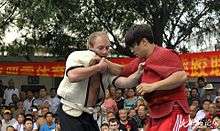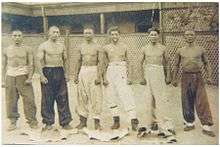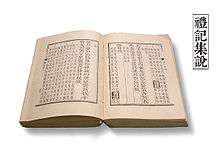Shuai jiao
Shuai Jiao (Chinese: 摔跤 or 摔角; pinyin: Shuāijiāo; Wade–Giles: Shuai-chiao) is the term pertaining to the ancient jacket wrestling wushu style of Beijing, Tianjin and Baoding of Hebei Province in the North China Plain which was codified by Shan Pu Ying (善撲营 The Battalion of Excellency in Catching) of the Nei Wu Fu (内務府, Internal Administration Unit of Imperial Household Department). In modern usage it is also the general Mandarin Chinese term for any form of wrestling, both inside and outside China. As a generic name, it may be used to cover various styles of wrestling practised in China in the form of a martial arts system or a sport. The art was introduced to Southern China in the Republican era (see Republic of China (1912–1949)) after 1911.[1]
 Two Shuai Jiao wrestlers testing each other in Tianjin, China. | |
| Also known as | Kung Fu Wrestling, Chinese Judo, Chinese Wrestling |
|---|---|
| Focus | Jacket wrestling, Grappling, Joint locks |
| Country of origin | |
| Creator | Unknown (said to be existed over 6,000 years) |
| Olympic sport | No |
History

Over 6,000 years ago, the earliest Chinese term for wrestling, "jǐao dǐ" (角抵, horn butting), refers to an ancient style of military Kung-Fu in which soldiers wore horned headgear with which they attempted to butt, throw and defeat their enemies. Ancient Chinese imperial records state that "jiao di" was used in 2697 BC by the soldiers of a rebel army led by Chiyou against the Yellow Emperor's army.[1] In later times, young people would play a similar game, emulating the contests of domestic cattle, without the headgear. Jiao di has been described as an originating source of wrestling and latter forms of martial arts in China.[2]
"Jiao li" (角力) was first referenced in the Classic of Rites[3] during the Zhou Dynasty. Jiao li supplemented throwing techniques with strikes, blocks, joint locks and attacks on pressure points.[1] These exercises were practiced in the winter by soldiers who also practiced archery and studied military strategy.[4]
Jiao li eventually became a public sport held for court amusement as well as for recruiting the best fighters. Competitors wrestled each other on a raised platform called a "lei tai" for the potential reward of being hired as a bodyguard to the emperor or a martial arts instructor for the Imperial Military. Jiao li was taught to soldiers in China over many centuries and its popularity among the military guaranteed its influence on later Chinese martial arts through the end of the Qing dynasty.
The term "shuai jiao" was chosen by the Central Guoshu Academy (Zhong Yang Guo Shu Guan 中央國術館) of Nanjing in 1928 when competition rules were standardized .[5] The art continues to be taught in the police and military academies of China.
Translation
The word "shuai," 摔, stands for "to throw onto the ground", while "jiao" may be one of two characters: the first and older, 角, stands for "horns" and the second and recent, 跤, stands for "wrestle or trip using the legs". In modern Chinese Shuai Jiao is always written using the more recent characters 跤, and should be translated as "to throw onto the ground through wrestling with legs". The use of the character 角 is because in the earliest form of Shuaijiao, players wore helmet with horns and head-butting was allowed. This form of Shuaijiao is called 'Ciyou Xi'.
Styles of Shuaijiao

Shuaijiao can be divided into the following styles:
Zhili (直隷) or Hebei (河北) Style. This style traces the lineage to the Yellow Emperor who fought two decisive battles against Chi You and Yan Emperor in modern-day Zhang Jia Kou (张家口) Region in Northern Hebei, to the NW of Beijing. The modern training methods and rules are codified by Shan Pu Ying (善撲营 The Battalion of Excellency in Catching) of the Nei Wu Fu (内務府, Internal Administration Unit of Imperial Household Department). It comprises Beijing, Tianjin and Baoding styles, listed below. Wrestlers wear a jacket called Da Lian.
Beijing Style (北京) - This is in essence the lineage from the Manchu Buku style that was practised by the Imperial Guards Brigade, Shan Pu Ying (善扑营, literally the Expert in Wrestling Unit). The main characteristic is the use of the legs to kick and off-balance opponents, and the use of arm locks.
Tianjin Style (天津) - This is the lineage of Ming Dynasty Shuaijiao mixed with Manchu Buku (布庫). The main characteristic is the use of legs to kick and off-balance, and the use of forearms in blocking and striking.
Baoding Style (保定) - This is the lineage that is called Kuai Jiao (快跤) or "Fast Wrestling". The main characteristic is the fast application of technique. Another characteristic is the adaptation of Shaolin Quan from Ping Jingyi, a famous teacher of Shuaijiao who learned Shaolin style from the Meng family of Nanguan County even though he was a Muslim Hui.
Shanxi Style (山西) - This is the lineage of Song Dynasty Shuaijiao. It is mainly practised in the counties between the mining city of Datong in northern Shanxi and the provincial capital Taiyuan in central Shanxi. The main characteristic is leg catching techniques, as traditionally wrestlers wear only tight knee-length pants.
Mongolian Style - This style traces its lineage to the wrestling styles of the Dong Hu (东胡) Confederation, which included Xianbei, Khitan and Mongol people.
See also
| Wikimedia Commons has media related to Shuai jiao. |
Notes and references
- "History of Shuai Jiao". Chinese Kuoshu Institute. Retrieved 2006-01-26.
- Zhongyi Tong, Tim Cartmell. "The Method of Chinese Wrestling".CS1 maint: uses authors parameter (link)
- Classic of Rites. Chapter 6, Yuèlìng. Line 108.
- Matuszak, Sascha (March 12, 2015). "Shuai Jiao: China's Indigenous Wrestling Style". Fightland.
- Burr, Martha. Ching, Gene. "Kungfu Styles of the Past Millennium". Kungfumagazine.com. Kung Fu Magazine. Retrieved 2006-01-26.CS1 maint: uses authors parameter (link)
General references
- Encyclopedic Dictionary of the Chinese Language, entry 35831.82
- Chinese Fast Wrestling for Fighting, Liang, Shou-Yu and Tai D. Ngo, ISBN 1-886969-49-3
- Journal of Asian Martial Arts Volume 15, No. 1, 2006. Via Media Publishing, Erie Pennsylvania USA. ISSN 1057-8358
External links
- ShuaijiaoNation.com Online Community
- United States Shuai Chiao Association
- European Shuai Jiao Union
- British Shuai Jiao Union
- Combat Shuai Chiao
- World Shuai Chiao Society: Shuai Chiao
- Mongolian Shuai Jiao Association: Shuai Chiao
- Shuai Chiao Association
- Middle Kingdom Wrestling - Chinese Pro Wrestling